For a long time, the concept of The Bike Lane and I haven’t exactly been friends. My experiences often involved navigating lanes that felt squeezed and unsafe, frequently positioned right next to equally narrow car lanes. And let’s not even start on the notorious door zone bike lanes – a design flaw that, frankly, should be relegated to history. Compared to confidently controlling the lane, these narrow bike lanes seemed to worsen passing distances and complicate intersection navigation, or at least demand more vigilance when approaching them. The supposed benefit of “my own space” never quite felt like a fair trade-off for these drawbacks.
Surprisingly, Well-Designed Bike Lanes Can Win Me Over
My perspective began to shift after moving to California. Here, I discovered the pleasure of riding in wide, buffered bike lanes. These are a different breed altogether, offering a genuinely comfortable space, sometimes feeling as spacious as a full traffic lane.
 Buffered bike lane with protection on both sides, creating a safe cycling space.
Buffered bike lane with protection on both sides, creating a safe cycling space.
Buffered on both the traffic and curb sides.
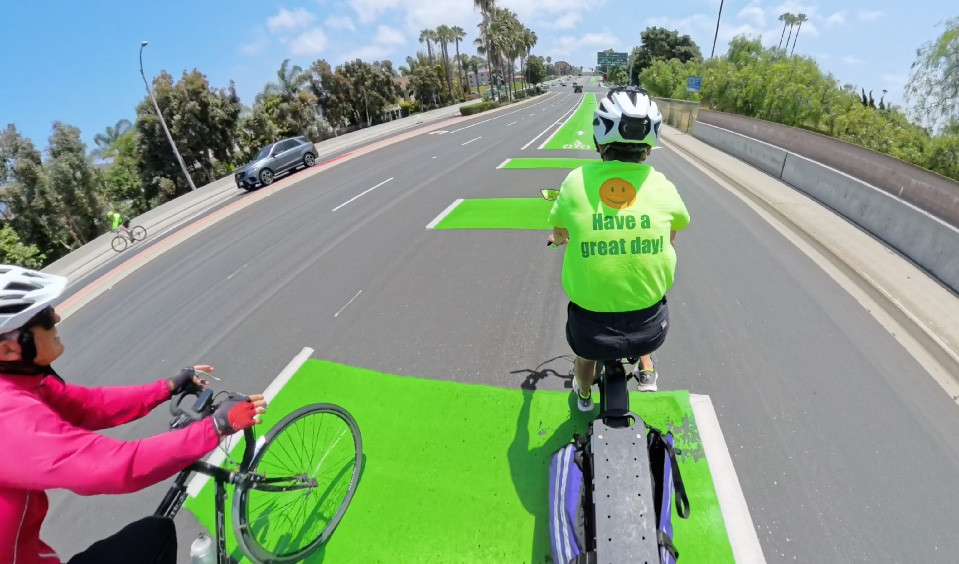 Wide bike lane situated between a through lane and a dedicated right turn lane, enhancing cyclist safety at intersections.
Wide bike lane situated between a through lane and a dedicated right turn lane, enhancing cyclist safety at intersections.
Large mixing zone designed for right-turning vehicles.
 Expansive mixing zone in a bike lane, facilitating safer right turns for motorists and clearer visibility for cyclists.
Expansive mixing zone in a bike lane, facilitating safer right turns for motorists and clearer visibility for cyclists.
Wide mixing zone to accommodate motorists making right turns.
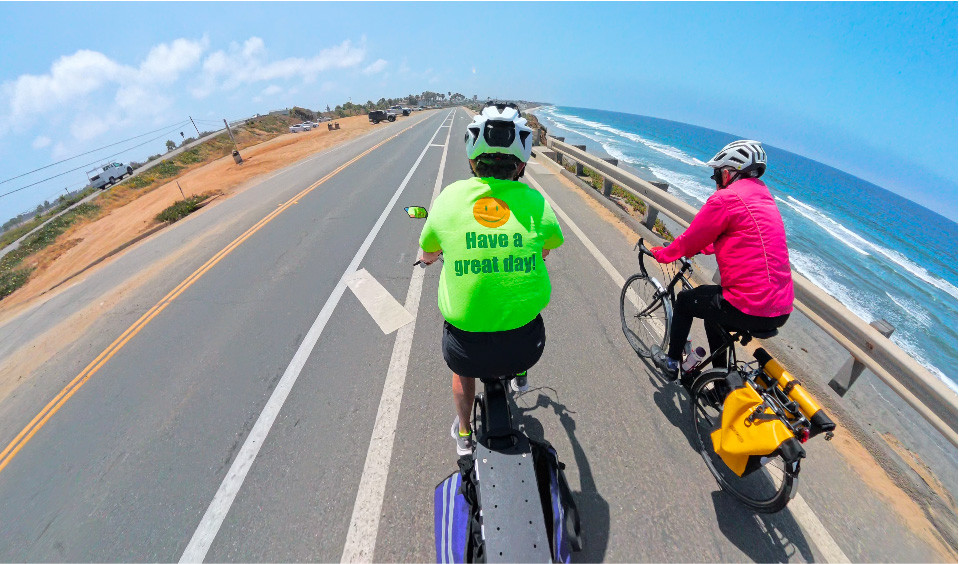 A broad, buffered bike lane along a beachside road, comfortably allowing two cyclists to ride side-by-side.
A broad, buffered bike lane along a beachside road, comfortably allowing two cyclists to ride side-by-side.
Wide bike lane, buffered on both sides, comfortably accommodates two cyclists riding abreast.
In a wide, buffered bike lane, riding alongside a companion becomes a relaxed experience. Intersection conflicts are largely mitigated, and it’s easy to adjust your position to the left to improve visibility. This design incorporates a generous mixing zone, which is intuitively understood by drivers merging for right turns. While vigilance for left cross-traffic is still necessary, the expansive clear area greatly improves both visibility and being seen. In many ways, it mirrors the experience of controlling the right lane on a multi-lane road, but with the added advantage of not sharing the lane with cars outside of these designated mixing zones.
The intuitive nature of a wide mixing zone makes it easier for motorists to merge before executing a right turn.
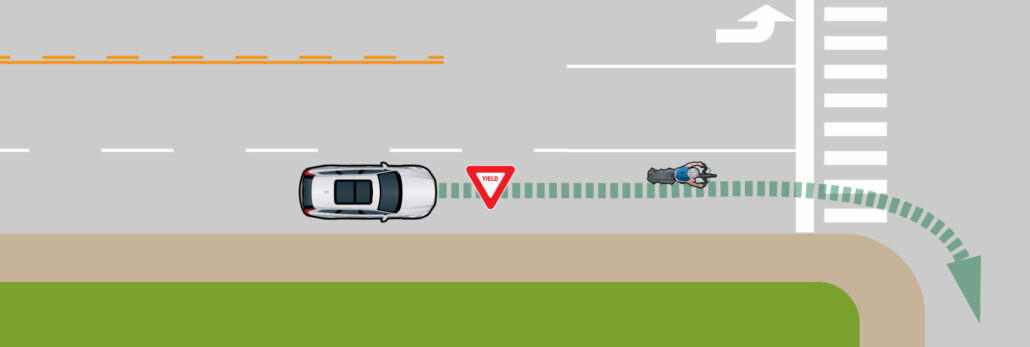 Cyclist confidently controlling a shared lane, effectively discouraging right hook collisions from turning vehicles.
Cyclist confidently controlling a shared lane, effectively discouraging right hook collisions from turning vehicles.
Lane control in a shared lane effectively discourages right hooks.
Buffered bike lanes provide cyclists with the space to maneuver left, enhancing their line of sight to vehicles entering from side streets.
 Buffered bike lane allowing a cyclist to improve visibility and avoid potential conflicts with entering vehicles.
Buffered bike lane allowing a cyclist to improve visibility and avoid potential conflicts with entering vehicles.
Left side lane position significantly improves visibility and vantage point.
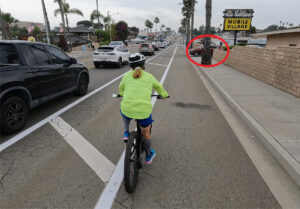 Image illustrating a cyclist positioned to see an approaching car, while the driver's view is partially blocked by roadside vegetation.
Image illustrating a cyclist positioned to see an approaching car, while the driver's view is partially blocked by roadside vegetation.
The cyclist is positioned far enough left to observe the car, but the driver’s line of sight is obstructed by a tree. Shifting slightly into the buffer would improve visibility for both parties.
Personally, I would lean towards a buffer on the right side. However, given the prevalent public fear of overtaking traffic – often overshadowing more common cycling hazards – the preference for a left-side buffer is understandable. Ultimately, as long as this buffered space is available for defensive riding and allows for lane changes in preparation for left turns, it serves its purpose.
But Are Buffered Bike Lanes “Enough” for Some Advocates?
To my dismay, I’ve observed a growing movement advocating for the transformation of these perfectly functional bike lanes into “separated” bikeways. This involves the addition of physical barriers like flex posts, bollards, curbs, and other similar installations.
While I understand the desire for a heightened sense of protection from cars, I must question the actual benefits versus the drawbacks. The crucial point is that this “protection” is largely illusory. Posts and curbs are unlikely to stop a moving vehicle effectively. However, they undeniably introduce new hazards for cyclists, leading to crashes. This is a well-documented risk with tangible consequences, including serious injuries. Alarmingly, these types of bicycle crashes often go unrecorded in national crash statistics because they are only tallied if they involve a collision with a moving motor vehicle.
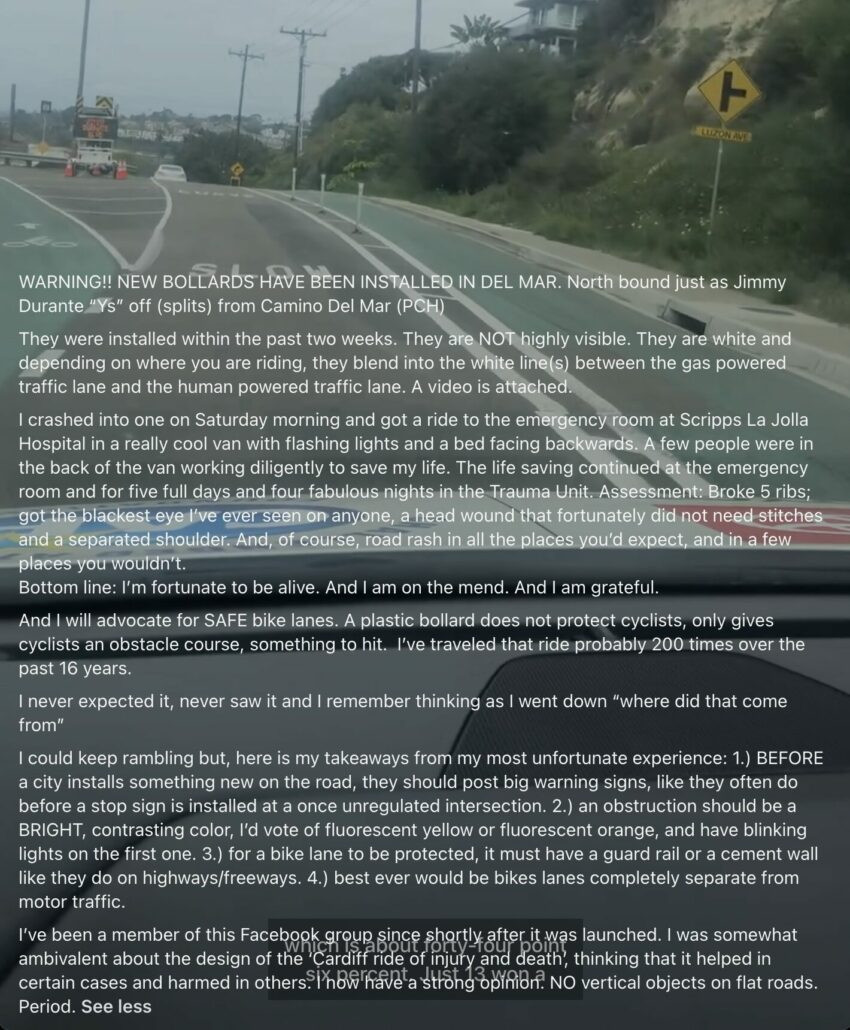 Image linking to a social media post detailing a cyclist's serious crash involving flex posts in a bike lane.
Image linking to a social media post detailing a cyclist's serious crash involving flex posts in a bike lane.
Click image to view the reel.
I never anticipated it, never saw it coming, and as I fell, I remember wondering, “Where did that even come from?”
This quote is from a cyclist’s account shared in the California Facebook group “Encinitas: PLEASE Restore Safety In Cardiff.” This individual sustained severe injuries after crashing into a post, spending five days in the hospital with injuries including five broken ribs, a separated shoulder, head trauma, road rash, and contusions.
These incidents highlight that barrier-related crashes are not minor occurrences; they represent a significant and often overlooked safety hazard.
Operational Drawbacks Introduced by Barriers
Barriers in bike lanes inherently reduce operational space and overall utility. A bike lane with just a painted buffer provides cyclists with the necessary room to overtake slower riders, avoid road debris, improve sight lines at obscured intersections, and change position to prepare for left turns. Introducing barriers significantly restricts or completely eliminates these essential maneuvers.
Placing a barrier within the buffer zone effectively shrinks the usable buffer space by more than half, as the barrier itself demands a safety margin.
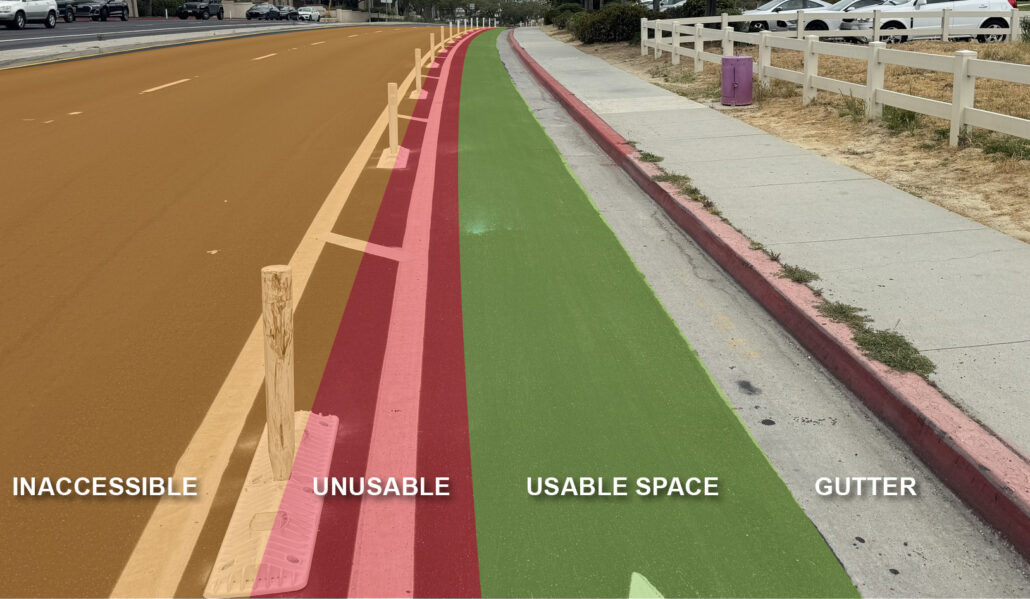 Image illustrating how posts in a buffered bike lane drastically reduce the available usable space for cyclists.
Image illustrating how posts in a buffered bike lane drastically reduce the available usable space for cyclists.
The posts diminish the benefits of the buffer. Without posts, the painted buffer would allow space for passing, hazard avoidance, and lane changes for left turns. Photo credit: Coach Darryl.
Furthermore, surface hazards become more problematic. Debris tends to accumulate in these separated lanes because specialized street sweepers are required to clean them effectively. This not only adds to the initial cost of barrier installation but also introduces ongoing expenses for maintenance. Damaged flex posts need replacement, and in the interim, broken pieces become additional hazards. This situation is detrimental for cyclists and costly for taxpayers.
In regions with cold climates, snow removal becomes complicated. Snow cannot be easily plowed to the curb, and meltwater refreezing across the bikeway can turn it into a treacherous sheet of black ice.
Potential ADA Accessibility Concerns
From my 15 years of teaching cycling safety, I’ve encountered numerous individuals with sufficient eyesight to ride a bicycle safely but who do not meet the vision standards for a driver’s license. For these individuals, cycling, combined with proper training, provides invaluable independent mobility. In areas with infrequent bus service and complex transfer routes, a bicycle is more than just recreation – it’s essential freedom. The challenge arises because many who cannot pass a driver’s vision test may also struggle to perceive subtle hazards. As the earlier anecdote illustrates, even cyclists with perfect vision can fail to notice posts and suffer crashes.
The accumulation of these downsides raises significant concerns.
What Problem Are We Truly Trying to Solve?
The Federal Highway Administration (FHWA) has promoted a claim of a 53% crash reduction by adding flex posts to bike lanes.
But how can this be reconciled with the realities of bike-car collisions?
Approximately 95% of bike-car crashes occur at intersections. Barriers offer no protection at these critical junctions or driveway crossings. In 2020, a cyclist in Encinitas, riding within a bollard-separated bikeway, tragically died after being struck by a right-turning truck entering a residential complex. Significantly, the bollards and buffer approaching that entrance have since been removed to allow vehicles to merge before turning, acknowledging the design flaw.
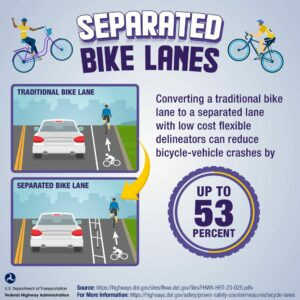 Image of a deceptive social media post by the FHWA, potentially misrepresenting the benefits of flex posts in bike lanes.
Image of a deceptive social media post by the FHWA, potentially misrepresenting the benefits of flex posts in bike lanes.
This image misleadingly compares a non-buffered bike lane to a buffered bike lane with flex posts. The improvement isn’t solely due to flex posts but also the increased buffer width – a confounding factor.
The research underpinning the FHWA’s claim specifically excluded intersections, focusing only on mid-block segments.
The relevant crash type in this context is a mid-block overtaking crash, which accounts for only about 5% of all bike-car crashes across all types of roads, including those without bike lanes. A significant portion of overtaking crashes are actually sideswipes in narrow lanes, resulting from motorists misjudging passing distance. Data from Mighk Wilson’s crash analysis in Orlando indicates that overtaking crashes on streets with bike lanes constituted just 1.5% of total crashes. It’s important to note that many bike lanes in the Orlando area are narrow and unbuffered. Paul Schimek’s research in Boston reached similar conclusions.
The FHWA document states that overtaking motorists cause one-third of Killed or Seriously Injured (KSI) crashes. However, in the Orlando metro area data, overtaking crashes represented 10% of KSIs, and overtaking crashes within bike lanes were a mere 2.1% of KSIs (14 crashes over seven years). While the percentage of overtaking KSIs is likely higher when rural roads are included in the dataset, separated lanes are not primarily proposed for rural environments.
Vehicle speeds and time of day are crucial factors. The risk on urban streets is minimal. Over seven years in Orlando, with 657 total KSI crashes, there were zero KSI bike lane overtaking crashes on 25-30 mph streets and only two on 35 mph streets, both occurring at night. On 40-50 mph roads, there were 38 KSI overtaking crashes, with 60% happening at night. If genuine crash mitigation is the goal, reducing traffic speeds and improving street lighting would be far more effective. Addressing traffic violations would also be beneficial. Many crashes are caused by careless driving, not unavoidable errors. Why then is the proposed solution to essentially confine cyclists?
For a more in-depth understanding, Mighk Wilson’s three-part series on his research provides valuable insights.
Research or Promotion?
The FHWA’s social media post and accompanying documentation bear a striking resemblance to a commercial advertisement. The use of an “up to” claim is a common advertising tactic to highlight the most favorable outcome while avoiding legal repercussions. Such claims are frequently seen in weight-loss programs, car advertisements promoting fuel efficiency or EV range, and similar contexts. However, from a government agency tasked with presenting research findings that impact public safety, this approach is concerning.
If the promoted finding is indeed a comparison between a bike lane with flex posts and one without, then the only valid comparison is between a bike lane with a painted buffer and one with a painted buffer plus flex posts. Ideally, this comparison should be conducted as a before-and-after study on the same roads to eliminate confounding variables that could distort the data.
It’s plausible that the buffer itself, not the posts, is responsible for any reduction in overtaking crashes. Perhaps an audible edge line on the buffer would offer similar benefits without the drawbacks of physical barriers – neither harming cyclists nor impeding their necessary movements within or across the buffer.
Public policy concerning safety should be based on sound evidence, not questionable data or emotional appeals.
Is it even statistically possible to achieve a significant number of overtaking crashes in buffered bike lanes to justify a 53% reduction claim? I have yet to see the comparative street data or crash data supporting this assertion. Based on long-term crash data from metro areas, I am skeptical that the bold claim of a 53% crash reduction is credible. The actual risk exposure is likely too low for such a dramatic reduction to be statistically meaningful.
If the risk were truly that high, we would face a far more pervasive societal problem than flex posts could ever resolve!
The Ethical Imperative for Engineers: First, Do No Harm
Transforming a functional and comfortable cycling facility into one that increases costs, diminishes mobility, and introduces new crash hazards demands compelling and irrefutable evidence of a net safety benefit. Ignoring the uncollected data on bicycle crashes not involving motor vehicles is unacceptable. Public policy affecting public safety must be grounded in robust findings, not innuendo or pandering to public sentiment.
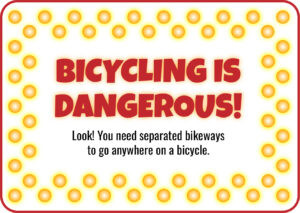 Image with the message: "Bicycling is Dangerous" highlighting the counterproductive messaging of overemphasizing cycling risks.
Image with the message: "Bicycling is Dangerous" highlighting the counterproductive messaging of overemphasizing cycling risks.
With vast networks of roadways, selectively adding separation to isolated sections while implying it’s essential for safety sends a discouraging message about cycling.
This brings me to a long-standing issue in cycling advocacy: a “the ends justify the means” mentality. At times, this approach borders on unethical (consider door zone bike lanes). Advocates who wish to promote cycling often push for facilities that feel safe to potential riders. However, creating a feeling of safety without enhancing actual safety, while simultaneously reducing the utility of an already adequate facility, is counterproductive. Worse, it propagates the misleading notion that even wide, buffered bike lanes are inherently unsafe unless fortified with barriers.
Separation: True Safety or Just for Show?
Even the most optimistic proponents of separated bikeways must acknowledge that they will never be universally implemented on every road. They are certainly not appropriate in all contexts. This is not to say that separated bikeways are never warranted; they can be justified in specific high-speed corridors. However, in such situations, the separation needs to be more substantial than flimsy flex posts if it is genuinely intended to protect cyclists from reckless drivers. Flex posts often serve as “separation theater” – a superficial measure that provides a visual cue but limited real protection. Overusing this type of facility in inappropriate settings is more likely to deter cycling than encourage it.
Administrators of the Encinitas Facebook group have been meticulously tracking injuries in the separated buffered bikeways on Highway 101 in Encinitas. This stretch of road was previously crash-free before the installation. They have now documented 32 crashes and counting, including a fatality.
The separated bikeway on HWY 101 has become so problematic that the right travel lane now features “May Use Full Lane” and shared-lane markings, indicating a recognition of the bikeway’s shortcomings.
